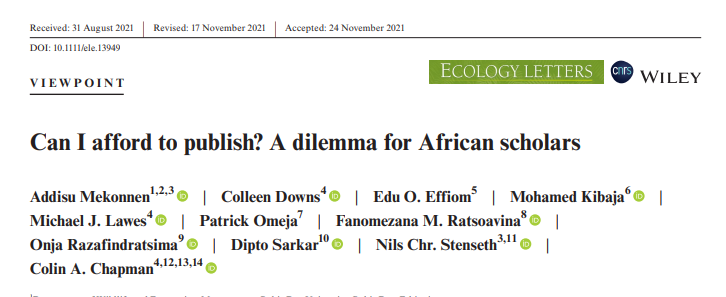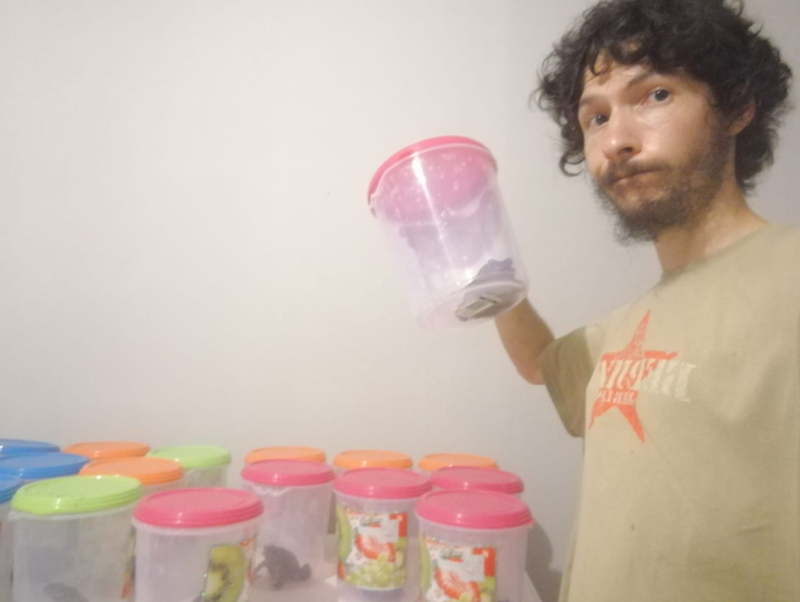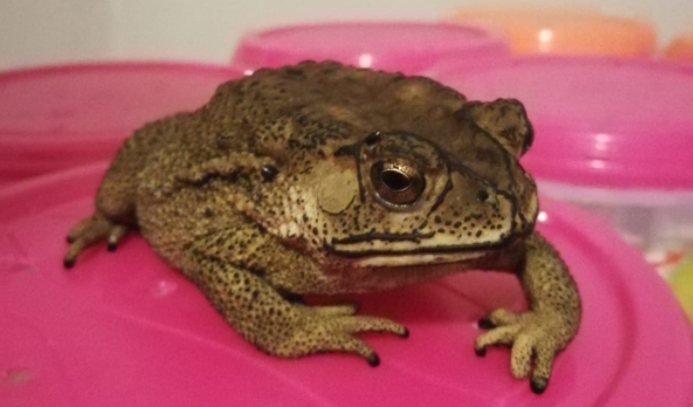The answer does not lie with publishers
Mekonnen et al. (2021) make some great points made about the current publishing model from an African perspective. It is frustrating that especially middle-income countries are being priced out of the Open Access (OA) market. We already know that these same countries are underrepresented in the ecological literature (e.g. Manlove & Belou 2018; Nuñez & Amano 2021). But while I agree with the sentiment and thrust of Mekonnen et al. (2021), they have missed the most important message on the future of scholarly publishing.

Mekonnen et al. (2021) have been duped into thinking that the solution lies with publishers. This is akin to suggesting that we turn over the problem with global climate change to the fossil fuel industry. The publishers, and in particular the big four (Elsevier, Springer-Nature, Wiley and Taylor-Francis control around 50% of all papers published in the biological sciences), are responsible for the current pricing structure and the revealing result in Mekonnen et al. (2021)’s Figure 1 - that we pay more for OA in journals with higher impact metrics. Gray (2020), who previously documented this trend, makes the much more important point that the so-called ‘impact metrics’ should never change the Article Processing Charge (APC) of publishing a manuscript. A higher imperative should be placed on the realisation that ‘impact metrics’ themselves have been captured by the publishers, who now sell them to our institutions and governments. Mekonnen et al. (2021) don’t even question why higher impact journals cost more; publishers produce the hierarchy and then exploit it. The movement away from assessing scientists on impact metrics for hiring and promotion is especially important, yet most African universities are notably absent from the Declaration of Research Assessment (DORA). The negative outcome of publishing metrics on scientists’ behaviour, including those in ecology, are now well recorded (Measey 2022). Turning away from metrics allows us to free ourselves from the tyranny of the publishers and their unethical pricing. Grossman & Brembs (2021) point out that the real costs of publishing are two orders of magnitude lower than those typically charged by publishers. But their most important result is that the actual cost of publishing Diamond OA journals (where neither author nor reader pays for access) is only ~$10 per paper.
The real question that Mekonnen et al. (2021) should have asked is: why are academics still using for-profit publishers when they are so obviously exploiting us?
Publishing science is changing, and it’s not just the OA movement. There is a far more important Open Science movement that needs to be given a much more prominent role. This involves preregistration of our research plans, preprints, open data, open code, open peer review and only then open publishing. If we look at what needs to be done, we should very quickly realise that publishers are the last people that we should be working with. Most of the innovations to Open Science will require institutional buy-in, and ultimately this must come from our own libraries as curators of our scholarly output (Measey 2022).
Mekonnen et al. (2021) are correct that African universities are currently paying a disproportionate price in the current publishing model, as are other middle-income countries and all those at less prestigious institutions. These same institutions have the most incentive to change the current publishing model into one that serves everyone better. A growing number of options are available.
The ‘overlay’ publishing model provides Diamond OA for journals at two orders of magnitude lower than for-profit publishers. Although the best examples (that even have their own Impact Factor) are in physics and mathematics, ecology joined the ranks using a ‘nearly overlay’ model in 2021 with the launch of Peer Community Journal. This builds on the Peer Community In initiative that has reviewed preprints since 2017, but now offers the option to publish in a growing suite of biological sciences: Evolutionary Biology, Ecology, Paleontology, Animal Science, Zoology, Neuroscience, Genomics and Mathematical & Computational Biology. The 2021 cost of publishing the first volume of Peer Community Journal was ~$65 per article, although these activities also covered the entire Peer Community In initiative.
Ecology Letters is published by Wiley on behalf of The French National Center for Scientific Research (CNRS). CNRS could instead end their publishing agreement with Wiley and move to an ‘overlay’ (or almost overlay) platform. CNRS has signed DORA, and so leaving Wiley and their for-profit publishing model would fit entirely within this commitment. According to OpenAPC CNRS paid €2 920 301 in APCs for 1724 articles - that's an overpayment of €2.9 million to the publishers, instead of setting up their own overlay publishing system! Moreover, in a world where ecology has all of its society journals with Diamond OA, who would ever choose to pay an APC to publish or hide their work behind a paywall?
Mekonnen et al. (2021) are correct when they say that the solutions lie with funders and the academic community. Currently, funders appear to be overly influenced by governments where the publishing lobbyists have already won the initiative. That leaves it up to us, the academics, and the societies that we run. We can choose Diamond OA today. We can sign DORA and we can make a movement away from for-profit publishing en masse. We can also use this opportunity to move towards Open Science, making us more accountable to the public who funds our work. If we can’t decide to make the move to Open Science ourselves, what is the real message that we are giving to society?
REFERENCES
Gray RJ. 2020. Sorry, we’re open: Golden open-access and inequality in non-human biological sciences. Scientometrics 124:1663–1675. DOI: https://doi.org/10.1007/s11....
Grossmann A, Brembs B. 2021. Current market rates for scholarly publishing services. F1000Research 10:20. DOI: 10.12688/f1000research.27468.2.
Manlove KR, Belou RM. 2018. Authors and editors assort on gender and geography in high-rank ecological publications. PLOS ONE 13:e0192481. DOI: 10.1371/journal.pone.0192481
Measey, J. 2022 How to publish in Biological Sciences: a guide for the uninitiated. CRC Press, Boca Raton. (OA at http://www.howtopublishscie...
Mekonnen, A., Downs, C. Effiom, E.O., Kibaja, M., Lawes, M.J., Omeja, P., Ratsoavina, F.M. et al. 2021. Can I Afford to Publish? A Dilemma for African Scholars. Ecology Letters . https://doi.org/10.1111/ele....
Nuñez MA, Amano T. 2021. Monolingual searches can limit and bias results in global literature reviews. Nature Ecology & Evolution 5:264–264. DOI: 10.1038/s41559-020-01369-w.



